Last week, Boeing’s next-generation CST-100 Starliner took off from Space Launch Complex 41 at Cape Canaveral, reached orbit, and docked with the International Space Station (ISS). Designated Orbital Flight Test-2 (OFT-2), this uncrewed test flight successfully validated the reusable space capsule for NASA’s Commercial Crew Program (CCP). This program, a public-private partnership between NASA and commercial launch providers (SpaceX and Boeing), aims to provide safe, reliable, and cost-effective payload and crew transportation to the ISS from American soil.
The mission came with its share of hiccups, which consisted of two of the spacecraft’s thrusters shutting off prematurely during orbital maneuvers. Nevertheless, this successful test flight was a welcome relief after three years of delays, checks, and corrective actions that followed the first failed attempt (OFT-1). After six days of being docked with the ISS, the spacecraft is scheduled to undock tomorrow autonomously (Wednesday, May 25th) and land at the White Sands Space Harbor at the U.S. Army’s White Sands Missile Range (WSMR) in New Mexico.
As part of the flight, the Starliner transported about 227 kg (500 lbs) of NASA cargo and crew supplies and more than 136 kg (300 lbs) of Boeing cargo to the ISS. This included the ID card of Boeing’s founder (Bill Boeing), flags and clothing from a group of Historically Black Colleges and Universities (HBCUs) that Boeing supports, a collection of tree seeds, and some Snoopy and Rosy the Riveter pins. But the piece de resistance was “Rosie the Rocketeer,” Boeing’s mannequin that simulates a crew member.
 A United Launch Alliance (ULA) Atlas V rocket carrying Boeing’s Starliner, launching for NASA’s Commercial Crew Program, lifts off from Space Launch Complex-41. Credit: ULA
A United Launch Alliance (ULA) Atlas V rocket carrying Boeing’s Starliner, launching for NASA’s Commercial Crew Program, lifts off from Space Launch Complex-41. Credit: ULA
The Starliner experienced a chamber drop in pressure during the test flight that caused two of its two Orbital Maneuvering and Attitude Control (OMAC) thrusters to prematurely shut off during the orbital insertion (OI) burn. This is not dissimilar to the error that prevented the Starliner from reaching the ISS during its inaugural flight (OTF-1), where a clock malfunction prevented the engines from firing at the correct time. However, the mission teams addressed the problem and found that it posed no risk for the rest of the flight test.
They also confirmed that the space capsule’s Guidance, Navigation, and Control (GN&C) systems performed nominally during the mission, the flight software executed its tasks as designed, and power generation was positive. The Starliner also successfully executed all of its autonomous demonstration burns and all rendezvous and docking maneuvers. Lastly, the mission provided vital data about how the vehicle operates in space and during autonomous docking procedures.
The rendezvous with the ISS was broadcast live via NASA Television, the NASA app, and the agency’s website. The return flight will also be broadcast live, beginning tomorrow at 02:36 PM EDT (11:36 AM PDT). Coverage of the deorbit burn, and the landing at White Plains Space Harbor will occur at 06:05 and 06:49 PM EDT (03:05 and 03:49 PDT), respectively. NASA TV will also host a news conference at the Johnson Space Center in Houston at 09:00 PM EDT (06:00 PM PDT).
In preparation for the return flight, NASA astronauts aboard the ISS closed the hatch of the Starliner capsule earlier today (at 03:00 PM EDT; 12:00 PM PDT). The spacecraft will return with more than 272 kg (600 lbs) of cargo, including reusable air tanks that will be refurbished and sent back to the ISS and the capsule’s “pilot” (aka. Rosie the Rocketeer!) The performance data obtained from this mission will prove vital when the Starliner conducts its first crewed mission to the ISS (CFT-1).
 NASA astronauts Bob Hines and Kjell Lindgren greet “Rosie the Rocketeer” inside the Boeing Starliner spacecraft shortly after opening its hatch. Credit: NASA
NASA astronauts Bob Hines and Kjell Lindgren greet “Rosie the Rocketeer” inside the Boeing Starliner spacecraft shortly after opening its hatch. Credit: NASA
This flight is expected to happen later this year, while astronaut selection for the mission is expected to occur this summer. Following certification from NASA, Boeing will be able to provide launch services alongside its competitor, SpaceX – which succeeded in its uncrewed test flight (Demo-1) to the ISS in2019 and has performed multiple crewed flights since. Like SpaceX’s Crew Dragon spacecraft, the Starliner will carry up to four crew members to the ISS, though its capacity allows up to seven astronauts.
These milestones are also very good news for NASA, which has historically favored a competitive environment when it comes to commercial partners and contracts. Considering Russia’s recent decision to withdraw from the ISS, having two launch service providers to transport crew and cargo to the ISS will be all the more beneficial.
Further Reading: NASA

